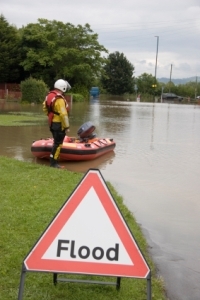Flash flood survival tips
By Catalogs Editorial Staff

Education is your first step toward safety.
Flash floods usually occur within six hours of a heavy rain or immediately following the failure of a dam or levy. There are some things you can do to help protect your home and your family should the unthinkable happen.
Insurance
Before a flood occurs, one of the best things you can do to protect your family is to make sure you have insurance. While this does not provide safety to your person, it will protect your home and your belongings. It must be noted that most homeowner’s policies do not cover floods, so ask your provider about the National Flood Insurance Program. This is especially important if you live in low-lying areas or if you live near bodies of water that make flash flooding a possibility. Make sure to keep your insurance papers and contracts in a safety deposit box or other safe place to ensure that in the event of a flood the information is not destroyed.
Awareness
Know your risk. Educate yourself on the elevation of the area you live in and the area’s susceptibility to flooding. Ask your local emergency personnel what to watch for and how much rain or water is a threat to your home. Know where higher ground is and devise a route to get there. During heavy rains, make sure to listen to your local radio or television station for flood warnings and other life-saving information. Watch for rising water levels and if in doubt, leave your home and move to safety.
~
Planning
If you live in an area that experiences floods frequently, set up a flash flood survival plan with your family. Decide on an escape route and a place where you will meet on higher ground, should a flood occur. Having family cell phones is a good idea to help you stay in contact with your loved ones during a flood or any emergency situation. Practice regularly to make sure everyone in the family knows the drill. The most important aspect of flash flood survival is making sure the people you love are safe.
Supplies
Stock emergency supplies in a bag in an easily accessible area such as the garage or storage closet. This will be important when you need to flee quickly. Having all of the necessary emergency items in one place will save time when you need to escape. This kit should include a few days’ worth of food and water, matches, a blanket, flashlight, first aid kit and other items that will be helpful in an emergency situation.
Higher Ground
Should you be caught in a flash flood, get to higher ground immediately. The biggest mistake people make in a flash flood is trying to drive, wade or swim across flooded areas. Swiftly moving water produces a great deal of force and as little as two feet of water will carry away an automobile. If you are in a vehicle when a flash flood hits, if possible back up and try another route ? do not try to drive through a flooded area. If you cannot back up or find a safe route, abandon your car and move to higher ground immediately.
Being caught in a flash flood is a scary and life-threatening situation. Flash flood survival depends on your ability to keep a level head and move to higher and safer ground. Following the aforementioned tips will help you and your family prepare for ? and survive ? a flash flood.
Popular Savings Offers






.jpg)




